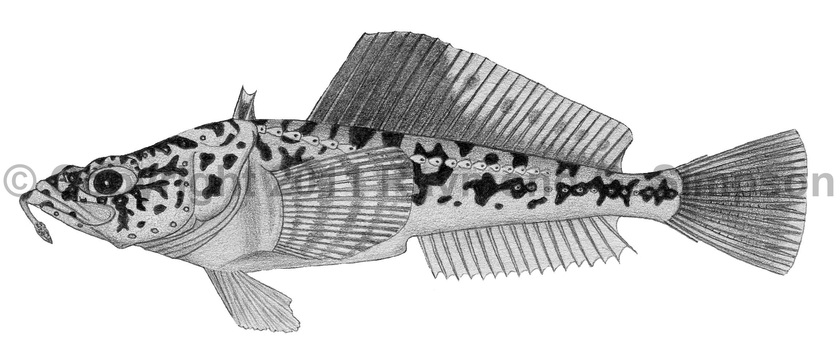
Common Name
Marmorated Plunderfish
Year Described
Norman, 1938
Identification
Dorsal Fin: II-III, 25-28
Anal Fin: 16-18
Pectoral Fin: 17-20
Pelvic Fin: I, 5
Caudal Fin: 8-11 (branched rays)
Gill Rakers: 16-21 (total in first arch)
Branchiostegal rays: 5
Upper Lateral Line Scales: 18-25 (tubular anteriorly, disc-shaped posteriorly)
Middle Lateral Line Scale: 9-19 (disc-shaped anteriorly and tube-shaped posteriorly)
Vertebrae: 36-38
A “marmorata group” plunderfish. Body elongate, flattened ventrally, with a large and wide head. Post-temporal ridges well developed. Eyes large. Snout flattened and constricted; length equal to orbit. Interorbital wide (7.1-11.0 in HL). Two dorsal fins: one a very small spiny fin over opercle and the other a long-based fin consisting of rays. Second dorsal quite high. Anal fin shorter in height with origin well behind dorsal origin. Pectoral fin large and fan-shaped. Pelvic fin jugular, rounded and fairly long. Caudal fin truncate. Lower jaw extends well beyond upper. Mouth reaching middle or orbit; protractile. Jaws with small teeth. No teeth on vomer or palate. Upper opercular edge with a pointed, hook-like projection. Body naked. Two lateral lines: one on the upper body ending under the mid-dorsal fin and the other on the lateral midline on the rear body and caudal peduncle. Mental barbel fairly short (2.5-4.6 in HL) with an expanded tip (2.5-3.0 times as wide as stalk and 30-60% of barbel length) covered in folds.
Color
Head and body light yellowish covered in dark spots and blotches, becoming smaller on dorsal surface. Belly unmarked pale or dark. Dorsal fin variable: from pale to dark or with a dark anterior lobe and spots posteriorly. Anal fin mostly light. Pectoral fin with 3-7 vertical bands. Pelvic fin pale, often with indistinct bands. Caudal fin either dark with pale edges or with several vertical bands. Barbel pale.
Size
Maximum size to 21cm L.
Habitat
Captured over a wide depth range (140-1,405m). Bottom dwelling. Feeds on worms and small crustaceans.
Range
Sub-Antarctic: known from the S. Shetland Is. and S. Orkney Is.
References
Balushkin, A.V. and R. Eakin. 1998. A new toad plunderfish Pogonophryne fusca sp. nova (Fam. Artedidraconidae: Notothenioidei) with notes on species composition and species groups in the genus Pogonophryne Regan. J. Ichthyol. 38(8):574-579.
Eakin, R.R. 1990. Artedidraconidae. p. 332-356. In O. Gon and P.C. Heemstra (eds.) Fishes of the Southern Ocean. J.L.B. Smith Institute of Ichthyology, Grahamstown, South Africa.